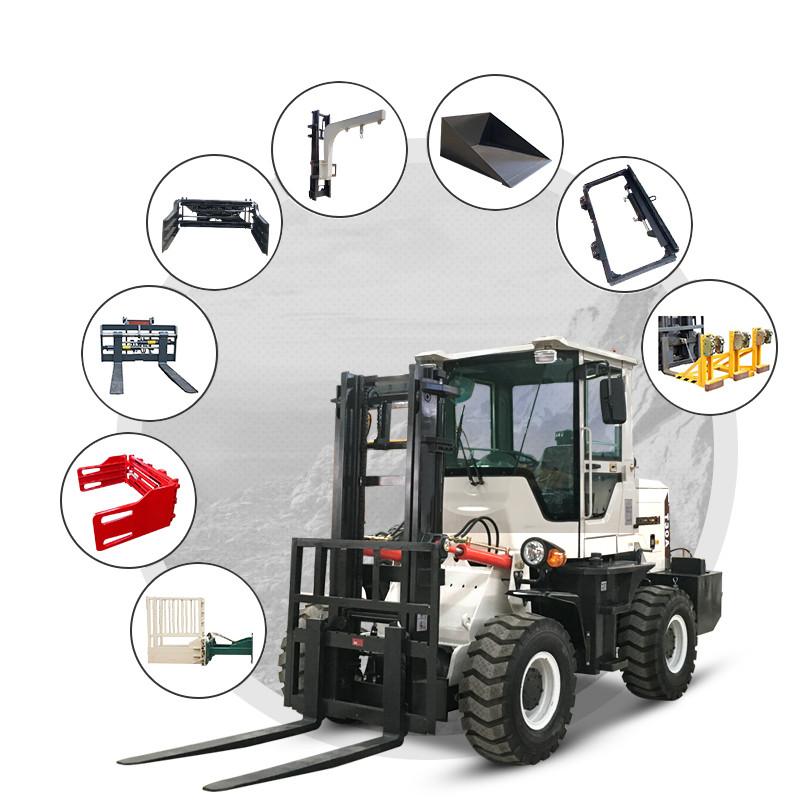The advantages of off-road forklifts compared with other forklifts are mainly manifested in the following aspects:

I. Passability and Terrain Adaptability
Four-wheel Drive System
It adopts an all-wheel drive (4WD) system without a differential lock between axles. Combined with large-diameter wide-base off-road tires, the minimum ground clearance is over 300 mm and the departure angle is above 30°, enabling it to easily handle complex terrains such as muddy ground, sandy ground, and snow-covered ground.
High Chassis Design
The chassis height is significantly higher than that of ordinary forklifts, which can avoid scraping of the chassis and enhance passability on rough roads.
Climbing Ability and Maneuverability
The maximum climbing ability is 25° - 30°, and the maximum driving speed is 40 km/h. Its maneuverability far exceeds that of ordinary forklifts.
II. Power and Operating Performance
Powerful Power Output
The engine has a larger power output. It adopts a hydrostatic transmission or hydrodynamic transmission system, with fast power response and low energy consumption, making it suitable for heavy-load operations (such as in mines and ports).
Compatibility with Multi-functional Accessories
It supports the quick replacement of accessories such as buckets, transverse package clamps, and drilling machines, enabling one machine to perform multiple functions and meet the needs of different scenarios (such as loading and unloading, excavation, and hoisting).
Stable Structural Design
The articulated frame has a swing angle of ±30° - 40°, combined with thickened articulated steel plates, ensuring the stability of the vehicle body during operation and avoiding deformation.
III. Environmental Adaptability
All-terrain Operating Capability
It can operate on unpaved roads in construction sites, oil fields, mountains, forests, etc., covering areas that ordinary forklifts cannot enter.
Response to Special Working Conditions
The anti-slip tire design improves the grip on slippery roads, and the explosion-proof battery version meets the requirements of dangerous environments such as chemical plants and cold storages.
IV. Economy and Maintenance Costs
Long Service Life and Low Maintenance
Adopting a reinforced chassis and durable components, the failure rate is lower than that of ordinary forklifts, and the maintenance cost is only one-third of that.
High Operating Efficiency
The turning radius in narrow passages is small (≤3 meters), increasing the space utilization rate by 30%, making it suitable for intensive operation scenarios such as ports and docks.
V. Comparison of Applicable Scenarios
Scenario | Advantages of Off-road Forklifts | Limitations of Ordinary Forklifts |
Mines/Oil Fields | Can carry heavy ores and adapt to sandy and muddy ground | Low chassis, prone to scraping and unable to climb slopes |
Construction Sites | Can independently handle steel bars and concrete without additional equipment | Requires coordination with other machinery for complex operations |
Ports/Docks | Can quickly load and unload containers and handle slippery roads | Large turning radius, prone to rollover |
Military/Emergency Rescue | Can quickly cross complex terrains and transport heavy equipment | Limited for indoor operations and has a single function |
Conclusion
Through designs such as the four-wheel drive system, high chassis, and multi-functional accessories, off-road forklifts perform outstandingly in complex terrains, heavy-load operations, and special environments. They are especially suitable for outdoor scenarios such as mines, ports, and construction sites. However, their disadvantages such as a large turning radius and limitations in indoor operations also need to be weighed according to actual needs.





